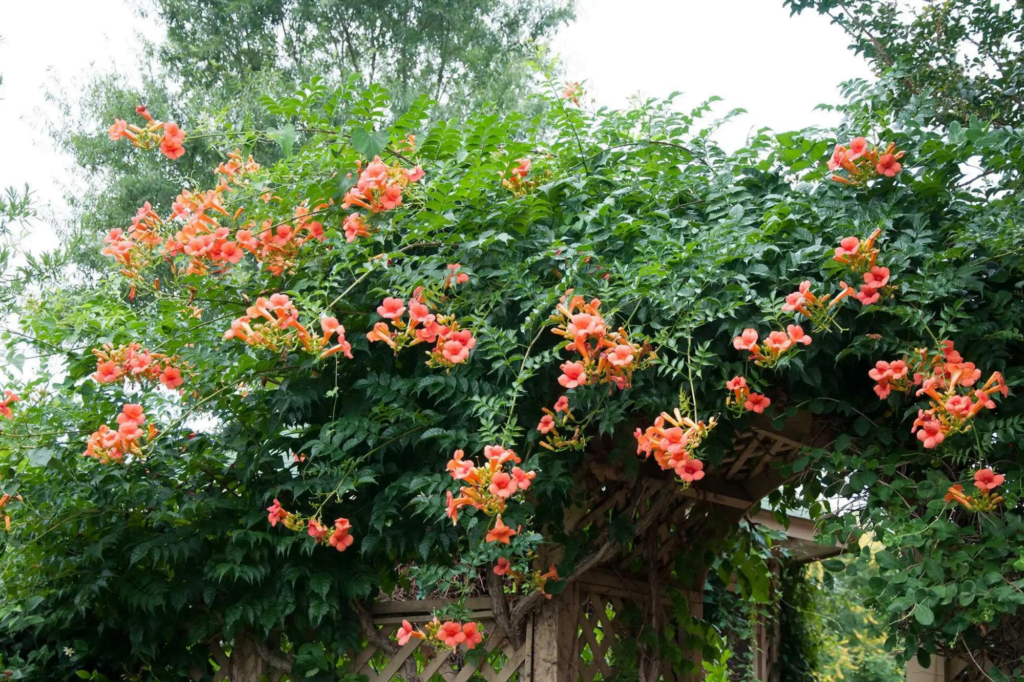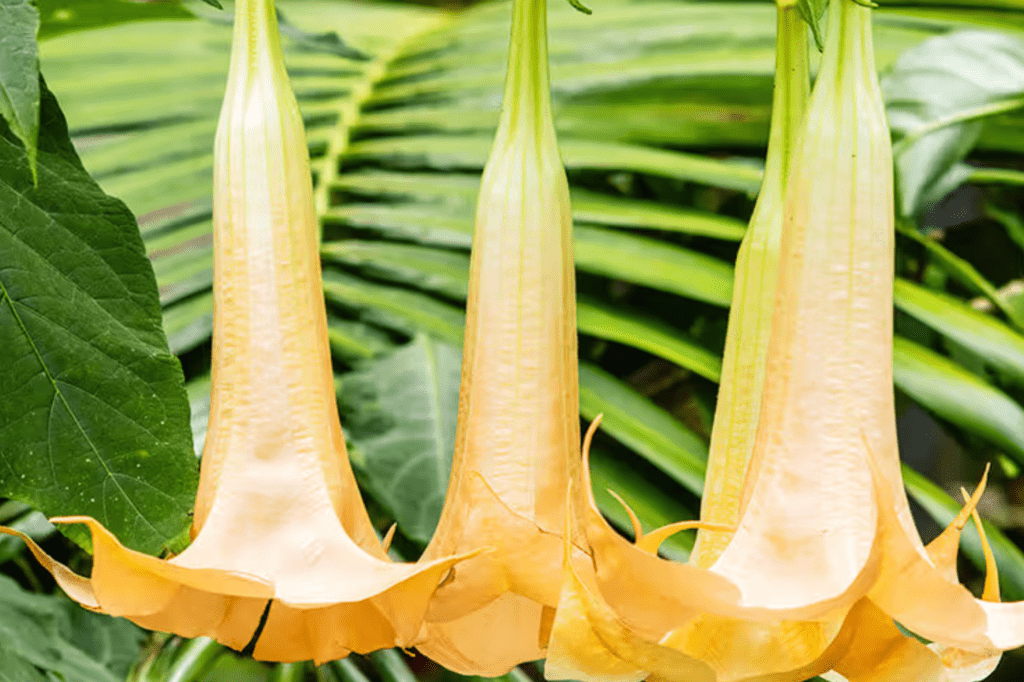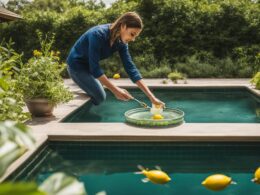- There are plants that look like trumpet vine but are not actually the same.
- It’s essential to identify these impostors in your garden to maintain a healthy and accurate flora environment.
- This article will help you recognize distinguishing features and characteristics of trumpet vine and similar plants.
- We will provide practical tips and descriptions of look-alikes to help you accurately identify plants in your garden.
Identifying Trumpet Vine Impostors
While trumpet vines are beautiful additions to any garden, they do have look-alikes that can cause confusion and misidentification. It’s important to be able to identify these plants accurately to avoid any gardening mishaps. Here are some tips and techniques for distinguishing trumpet vine from similar plants:
Here are some tips and techniques for distinguishing trumpet vine from similar plants:
Pay Attention to Leaf Shape and Color
Trumpet vine leaves are elongated and oval-shaped, with a pointed tip. They are bright green and somewhat shiny on the top surface, while the underside is slightly paler and not as shiny. Other plants, such as poison ivy, Virginia creeper, and Boston ivy, have similarly shaped leaves, but they are not the same bright green color as those of trumpet vine.Observe the Flowers
Trumpet vine flowers are unique and easily distinguishable. They are large and trumpet-shaped, with a deep orange-red color. When in bloom, the vines are covered in clusters of these bright flowers. If a plant is not covered in trumpet-shaped flowers, it is likely a different plant.Look at the Growth Habit
Trumpet vines are vigorous climbers that can grow up to 40 feet in height. They climb using aerial roots and tendrils that can latch onto anything they encounter. While some other plants, such as wisteria and clematis, also have twisting and twining stems, they are not as aggressive as trumpet vine. By paying attention to these distinguishing features, you can identify trumpet vine impostors and ensure that your garden is a healthy and vibrant environment for these beautiful vines to thrive.Trumpet Vine Look-Alikes
There are several plants that look similar to trumpet vine, making it difficult to distinguish them. It’s important to be able to recognize these look-alikes so you can make sure you are planting the correct species. Here are some plants that can be mistaken for trumpet vine:| Plant | Description |
|---|---|
| Campsis radicans ‘Flava’ | Yellow flowers instead of orange-red |
| Campsis grandiflora | Larger flowers with orange-red and yellow markings |
| Bignonia capreolata | Small yellowish-green flowers |
| Tecoma stans | Yellow flowers with less pronounced trumpet shape |
Distinguishing Trumpet Vine from Other Plants
When it comes to identifying plants that resemble trumpet vine, it’s important to pay close attention to the plant’s characteristics. Trumpet vine has a unique combination of features that set it apart from other vines, shrubs, and plants. One of the defining characteristics of trumpet vine is its compound leaves, which contain multiple leaflets. These leaflets are typically elongated in shape with pointed tips and toothed edges. While other plants may have similar leaf shapes, the combination of multiple leaflets in a compound leaf is a key feature of trumpet vine.
The flowers of trumpet vine are another distinctive feature. They are trumpet-shaped, hence the name, and range in color from red-orange to yellow. The flowers grow in clusters and have a flared opening, making them easily recognizable.
Trumpet vine also has a fast-growing and aggressive growth habit. It can climb high and wide, and its aerial rootlets can cling to walls, fences, and other structures. Other plants may have similar growth habits, but few will match the spectacular vigor and spread of trumpet vine.
Finally, trumpet vine has a woody stem that can become quite thick over time. This is in contrast to other vines and plants that may have thinner, more flexible stems.
By paying attention to these distinguishing features, you can accurately identify trumpet vine and distinguish it from other similar plants in your garden.
One of the defining characteristics of trumpet vine is its compound leaves, which contain multiple leaflets. These leaflets are typically elongated in shape with pointed tips and toothed edges. While other plants may have similar leaf shapes, the combination of multiple leaflets in a compound leaf is a key feature of trumpet vine.
The flowers of trumpet vine are another distinctive feature. They are trumpet-shaped, hence the name, and range in color from red-orange to yellow. The flowers grow in clusters and have a flared opening, making them easily recognizable.
Trumpet vine also has a fast-growing and aggressive growth habit. It can climb high and wide, and its aerial rootlets can cling to walls, fences, and other structures. Other plants may have similar growth habits, but few will match the spectacular vigor and spread of trumpet vine.
Finally, trumpet vine has a woody stem that can become quite thick over time. This is in contrast to other vines and plants that may have thinner, more flexible stems.
By paying attention to these distinguishing features, you can accurately identify trumpet vine and distinguish it from other similar plants in your garden.
Trumpet Vine Impostor Characteristics
When trying to identify trumpet vine impostors, it’s important to understand the key characteristics that differentiate them from the real thing. Here are some of the most common traits that impostor plants may have:| Characteristic | Description |
|---|---|
| Leaf shape | Impostors may have leaves that are similar in size and shape to trumpet vine but not quite the same. |
| Flower color | While many trumpet vine impostors have flowers that are orange or red, they may be a different shade or hue than true trumpet vine flowers. |
| Growth habit | Impostors may have a different growth pattern, such as a more compact or bushy shape, than trumpet vine. |
| Climbing structure | Impostors may have a different climbing structure, such as twining instead of aerial roots, than trumpet vine. |
What Unique Traits Do Plants That Look Like Trumpet Vine Share?
Plants resembling trumpet vine share unique traits in terms of trumpet vine flower adaptations. These plants have similar features such as elongated blooms, tubular structures, and flamboyant colors. These adaptations attract pollinators like hummingbirds and insects, enabling effective pollination and seed dispersal. The unusual resemblance and shared adaptations make them stand out in the botanical world.
Recognizing Trumpet Vine Impostors in Your Garden
Now that you know how to identify impostors, it’s important to be able to apply this knowledge in your garden. Here are some practical tips for recognizing trumpet vine impostors:- Observe the leaves: As we discussed earlier, the leaves of trumpet vine are compound leaves with serrated edges. Many of the impostors have leaves that are simple and not serrated.
- Examine the flowers: Trumpet vine has bright orange-red trumpet-shaped flowers that bloom in mid-summer to fall. Impostors may have similar but smaller and paler blossoms, or completely different shapes and colors.
- Pay attention to growth habits: Trumpet vine is a vigorous vine that can grow up to 40 feet tall with aerial roots that attach to structures. Impostors may be bushy or have different growth patterns.
- Check for invasive tendencies: While trumpet vine is known to be invasive in some areas, some of its impostors can be even more aggressive. Research the invasive characteristics of the plants in question before introducing them to your garden.









